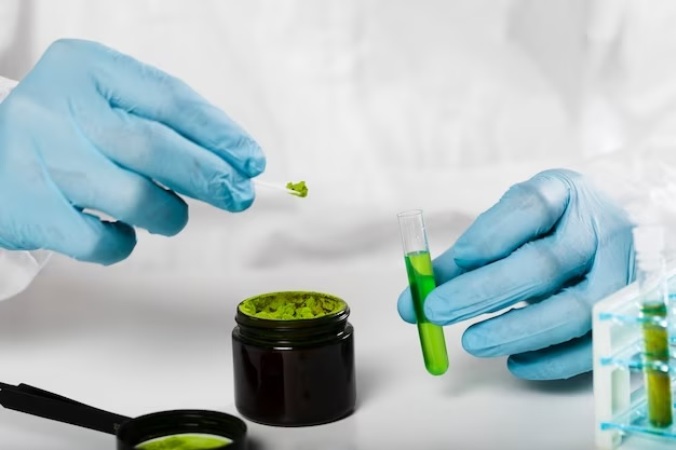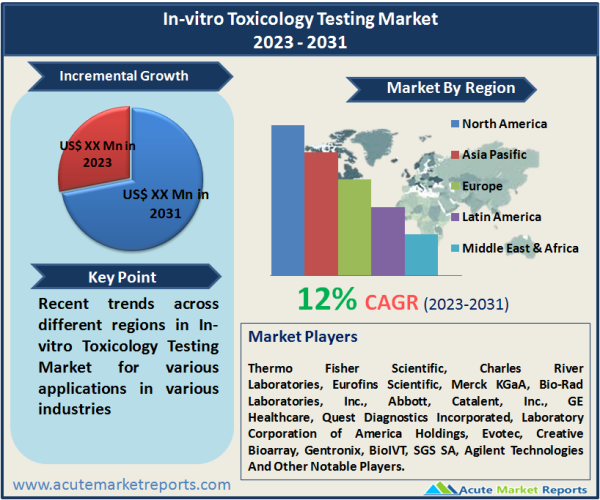
The in-vitro toxicology testing market is at the forefront of modern safety assessment, playing a pivotal role in various industries. The in-vitro toxicology testing market is expected to grow at a CAGR of 12% during the forecast period of 2025 to 2033, driven by advancements in products and services, regulatory pressures, and cost-effectiveness. While limitations in replicating complex biological responses remain a restraint, the advantages of in-vitro testing in terms of cost and time efficiency make it a preferred choice for safety assessment. Market segmentation by type and technology highlights specific areas of growth, and geographic trends underscore the significance of regional variations in demand. Competitive players are expected to focus on innovation and diversification to address evolving industry needs and regulatory expectations. The In-vitro Toxicology Testing market is well-positioned to continue shaping the future of safety assessment in various sectors.

Advancements in Product & Service
One of the primary drivers of the In-vitro Toxicology Testing market is the continuous advancement in product and service offerings. The market is witnessing a surge in the development of cutting-edge assays, consumables, equipment, software, and services. The constant evolution of these products and services empowers researchers and organizations to conduct in-vitro toxicology assessments with greater accuracy and efficiency. The introduction of high-throughput technology, sophisticated molecular imaging tools, and comprehensive OMICS technology has revolutionized toxicological testing, facilitating more reliable predictions of substance safety and toxicity.
Regulatory Pressure and Ethical Concerns
The global regulatory landscape has become increasingly stringent, emphasizing the importance of safety evaluations for chemicals and pharmaceuticals. In-vitro toxicology testing plays a pivotal role in addressing these regulatory requirements. Moreover, ethical concerns surrounding animal testing have amplified the demand for in-vitro alternatives. The use of in-vitro methods not only reduces the reliance on animal experimentation but also offers the advantage of quicker, cost-effective, and more humane safety assessments. Stringent regulatory guidelines from global agencies and an increasing number of organizations adopting in-vitro methods as a means of fulfilling ethical responsibilities.
Cost-Effectiveness and Time Efficiency
In-vitro toxicology testing offers substantial cost savings and time efficiency compared to traditional in-vivo testing methods. The conventional method of animal testing is not only expensive but also time-consuming, often resulting in delays in product development. In-vitro testing streamlines the safety assessment process, enabling quicker decision-making and reducing the overall cost of research and development. This economic and time advantage has made in-vitro testing a preferred choice for pharmaceutical companies, chemical manufacturers, and regulatory agencies.
Restraint in the In-vitro Toxicology Testing Market
One of the primary restraints in the In-vitro Toxicology Testing market is the challenge of recreating complex biological responses outside of a living organism. While in-vitro tests have made significant progress in predicting various aspects of toxicity, they still struggle to accurately mimic the intricate interactions that occur within a whole organism. This limitation raises concerns about the potential for false negatives or positives in safety assessments, which can have serious consequences for human health and the environment.
Market Segmentation by Type (Product & Service, Assays, Consumables, Equipment, Software, Services): Assays Dominate the Market
The In-vitro Toxicology Testing market can be segmented by type into five categories: Product and service, Assays, Consumables, Equipment, Software, and Services. In 2024, "Assays" generated the highest revenue. These in-vitro testing kits and tools provide precise and targeted information about toxicity, making them indispensable in various industries. For the period from 2025 to 2033, "Services" are expected to exhibit the highest compound annual growth rate (CAGR). In-vitro toxicology testing services, including expert consultation, assay development, and data analysis, are anticipated to increase demand as organizations seek specialized assistance for safety assessments.
Market Segmentation by Technology (Cell Culture Technology, High Throughput Technology, Molecular Imaging, OMICS Technology): High Throughput Technology Dominates the Market
The In-vitro Toxicology Testing market can be segmented by technology into four categories: Cell Culture Technology, High Throughput Technology, Molecular Imaging, and OMICS Technology. In 2024, "High Throughput Technology" generated the highest revenue. This technology enables the rapid screening of a large number of substances, making it a crucial tool for pharmaceutical and chemical industries. For the period from 2025 to 2033, "OMICS Technology" is expected to experience the highest CAGR. OMICS technology, encompassing genomics, proteomics, and metabolomics, is gaining prominence for its ability to provide comprehensive insights into the effects of substances on biological systems.
North America remains the Global Leader
The In-vitro Toxicology Testing market exhibits geographic variations in demand and growth. Geographic trends indicate that regions with stringent regulatory environments and ethical concerns have a higher demand for in-vitro testing methods. North America, with its well-established pharmaceutical and chemical industries and strict regulatory standards, has been a prominent market for in-vitro toxicology testing. In terms of the region with the highest CAGR during the forecast period from 2025 to 2033, Asia-Pacific is expected to experience substantial growth. The region's expanding pharmaceutical and chemical sectors, coupled with a growing emphasis on regulatory compliance, contribute to its prominence in the market. Regarding revenue percentage, North America is anticipated to maintain its position as the region with the highest revenue percentage throughout the forecast period. The region's investment in research and development and a strong presence of key market players contribute to its substantial market share.
Competitive Trends, Top Players, and Key Strategies
The In-vitro Toxicology Testing market features several key players, including Thermo Fisher Scientific, Charles River Laboratories, Eurofins Scientific, Merck KGaA, Bio-Rad Laboratories, Inc., Abbott, Catalent, Inc., GE Healthcare, Quest Diagnostics Incorporated, Laboratory Corporation of America Holdings, Evotec, Creative Bioarray, Gentronix, BioIVT, SGS SA, and Agilent Technologies. These companies employ specific strategies to maintain and expand their market presence. In 2024, Thermo Fisher Scientific held a significant market share, offering a comprehensive range of in-vitro toxicology testing solutions and services. The company's strategy focused on research and development to introduce innovative assays and testing platforms. Charles River Laboratories, a global leader in contract research services, excelled in providing specialized toxicology testing services. Their strategy emphasized collaboration with pharmaceutical and biotechnology companies to support drug development efforts. Eurofins Scientific, a prominent player in the market, positioned itself as a key provider of in-vitro assays and testing services. Their strategy centered on expanding their portfolio to include the latest technologies and diversifying their offerings. For the forecast period from 2025 to 2033, these companies are expected to continue their strategies, focusing on innovation, specialization, and expanding their service and technology portfolios to meet the evolving needs of the industry and ensure safety assessments of substances.
Historical & Forecast Period
This study report represents analysis of each segment from 2023 to 2033 considering 2024 as the base year. Compounded Annual Growth Rate (CAGR) for each of the respective segments estimated for the forecast period of 2025 to 2033.
The current report comprises of quantitative market estimations for each micro market for every geographical region and qualitative market analysis such as micro and macro environment analysis, market trends, competitive intelligence, segment analysis, porters five force model, top winning strategies, top investment markets, emerging trends and technological analysis, case studies, strategic conclusions and recommendations and other key market insights.
Research Methodology
The complete research study was conducted in three phases, namely: secondary research, primary research, and expert panel review. key data point that enables the estimation of In-Vitro Toxicology Testing market are as follows:
Market forecast was performed through proprietary software that analyzes various qualitative and quantitative factors. Growth rate and CAGR were estimated through intensive secondary and primary research. Data triangulation across various data points provides accuracy across various analyzed market segments in the report. Application of both top down and bottom-up approach for validation of market estimation assures logical, methodical and mathematical consistency of the quantitative data.
| ATTRIBUTE | DETAILS |
|---|---|
| Research Period | 2023-2033 |
| Base Year | 2024 |
| Forecast Period | 2025-2033 |
| Historical Year | 2023 |
| Unit | USD Million |
| Segmentation | |
Product & Service
| |
Method
| |
Technology
| |
Toxicity Endpoint & Test
| |
End-User
| |
|
Region Segment (2023-2033; US$ Million)
|
Key questions answered in this report